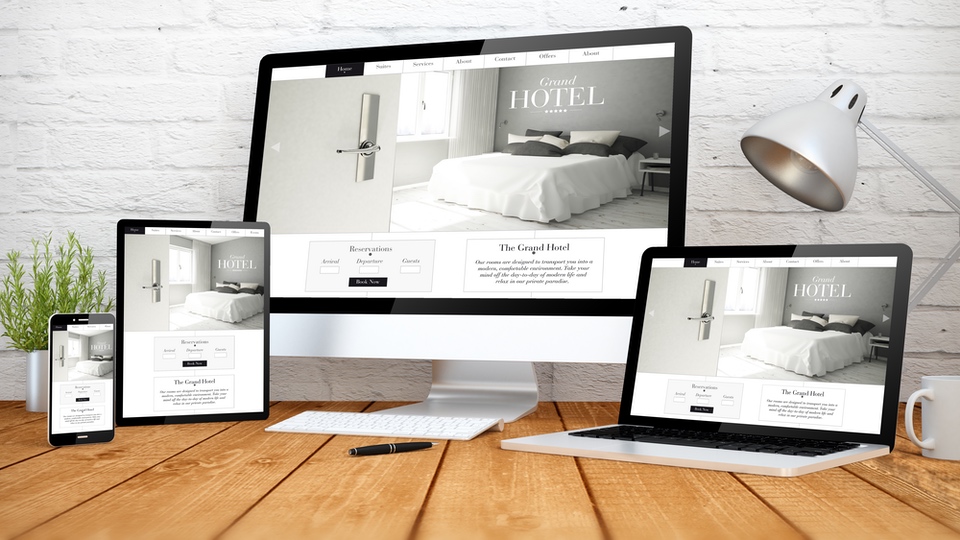5 Hotel Website Design Tips to Increase Direct Bookings

When was the last time you thought about your hotel website’s design? As many hospitality marketers are tasked with doing more with less, it can be challenging to keep up with the constantly-changing website trends.
But as hotels push further into a recovery from a difficult 2020, the key to driving more direct bookings just might be moving past the standard Brand.com website or freshening up that website that is 3-years-old and counting.
Interested in optimizing your hotel website’s design for more direct conversions? Let’s look at five important tips that can put you on the right path.
1. Make sure your hotel website has a responsive mobile design
Each year, more than 100 million people book hotels online, and those bookings are increasingly occurring on a number of different devices. According to 2021 travel data, 83% U.S. adults prefer to book their trips online and 700 million people are expected to make a booking online by 2023. The customer journey often begins on mobile devices with 70% of people researching their travel on a smartphone to begin the process.
That is all to say that having a responsive website is at the top of the list of hotel website design musts in the 2020s and beyond. More than 40% of today’s consumers come from Gen Z, and 60% of Gen Z books travel online via a mobile device. That trend will continue, which is why Google has put emphasis on mobile speed.
When building your hotel website for now and the years to come, it’s important to keep mobile top of mind and ensure the page and its elements adapt to not only a desktop but also a tablet and smartphone. Mobile page speed became an even bigger factor in 2020 when Google switched to mobile-first indexing. The search giant now prioritizes these mobile scores to rank your website in search results. How do you stack up?
2. Keep your site and navigation options simple
With all the third-party integrations and modules available, it can be tempting to overload your website with interactive elements and content for the user. But sometimes, less is more. Keeping your website design simple ensures that the important information stands out, and it can also keep your site running fast.
The navigation bar is one of the most important elements of your website, so make sure it’s distinct from the rest of the page, yet simple. Only include the most important pages rather than stuffing every sub-page for your rooms or hotel features. Drop-down menus—and on mobile a hamburger menu—are your friend. It’s important to have navigation consistency across all pages and make placement decisions strategically. Consider which pages are most important and order based on the customer journey.
3. Showcase your hotel and your location’s unique personality
As consumer behavior has shifted and hoteliers have been pushed to further stand out against competitors and other hotels down the street, many have moved on from the cookie-cutter Brand.com websites in favor of more lively and custom websites that show off their property’s personality and the features of the surrounding area.
It’s no secret that having photos and video help drive higher engagement and increase booking inquiries. But just as important as having vivid imagery is a design that matches your typical guest’s buyer persona. Is your hotel geared toward leisure travel? Including design elements that show off nearby attractions and restaurants is important. Is your hotel more business-oriented? Maybe you should include information about your shuttle service, Wifi availability and fitness center.
The Mountain Club on Loon is a perfect example of a hotel website designed with the target audience in mind. A ski resort in New Hampshire, the hotel website shows off the scenery as well as nearby dining, attractions in the area, and the hotel’s spa. The result was a more engaging website that drove increased conversions.
4. Immerse potential guests with virtual tours
While you’ve been told to keep your hotel website simple, there is a fine line between simplicity and providing travelers with the dynamic content they’re looking for.
In a recent blog about hospitality marketing trends for 2021, we discussed the takeoff of virtual tours. This immersive experience became more prevalent during the pandemic and is becoming an important conversion tool for hotels. Not quite ready to unleash virtual tours of your rooms and other property amenities? Photos and videos are still great ways to add personality and draw in travelers.
5. Make booking a room simple
The ultimate goal of your hotel’s website is to drive direct bookings. So more than anything, when thinking about your website’s design, it’s important to keep that end goal in mind and not lose sight of what will help get you there.
That leads to two key tips:
- Make your Calls-to-Action (CTAs) stand out: Mobile speed, a clean navigation and a simple design all lead to this. It’s important to provide users with design cues and make your CTAs stand out. You can do this with color as well as actionable content that leads the traveler through the customer journey.
- Find a user-friendly booking engine: This is especially important for smaller and independent hotels. A cumbersome booking engine and poor user-experience can lead to drop-off right when a user is ready to convert. Make sure your booking engine is simple (the fewer steps the better) and secure.
Have questions about how your hotel should approach a website redesign? Reach out. Or, follow our blog for more tips on hospitality marketing and website design.

